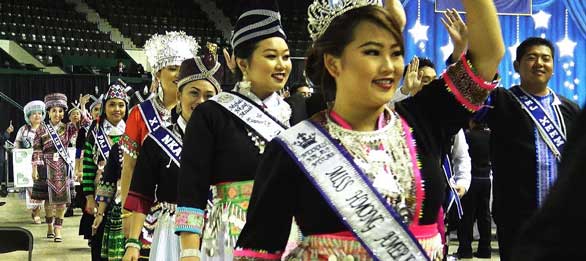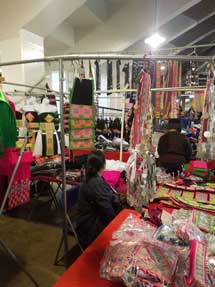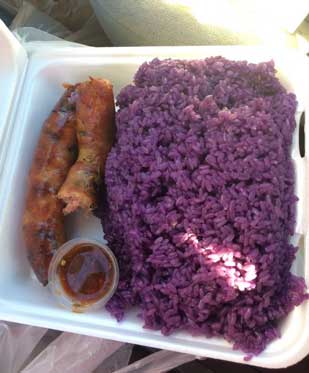Winter in Falcon Heights, Minnesota will not be the same this year as the 22nd annual Hmong New Year festival at Lee and Rose Warner Coliseum on the Minnesota State Fair Grounds is called off due to COVID-19. 2020 has been a year of challenge, loss, education, and adaptation for the human race across the globe, and the cancellation of this beloved Hmong festival is just one more tragedy.
Last year, Hmong Times had the opportunity to speak to the event’s first ever chairwoman, Pakou Yang, and the essential element of what it means to be Hmong was expressed as the Hmong language, the vibrant Hmong apparel, and the love of family. Remembering one’s roots and appreciating details of one’s identity can bring people closer together, which is especially crucial during these times of quarantine.
Yang described that the Hmong New Year’s festival at Lee and Rose Warner Coliseum is special because it implements the essential Hmong New Year’s traditional rituals like the lwm sub event. Lwm Sub is a ceremony in which a spiritual elder or lead of a particular clan or household, respectively, blesses the walkway under a suspended string of woven leaves and twine and has family and friends walk under the string in repetition as he/she calls away evil spirits to leave with the passing of the old year and wills for blessings to come in with the new year. “A famous event this is,” Yang had said, “And the elderly, widowed and spouseless really appreciate it when performed at the coliseum New Year because at home, they have no such head of household to perform the ritual.”
Such events will be dearly missed. And also undoubtedly missed are the delicious iconic foods such as steaming hot purple sticky rice with Hmong sausage diagonally sliced, papaya salad made to spice level perfection, and creamy coconut iced tricolor. But a crucial part of the tradition of the coliseum Hmong New Year’s festival is its beauty and skill pageant for girls and the Prince Charming pageant for boys. Throughout the years, skillset of the participants have ranged from singing, dancing, and musical instrument talents, to cultural chanting, storytelling, and qeej playing. Then often follows the answering of a political, social, or communal question selected at random and then a statement of communal purpose if granted the title. A panel of judges gives scores and final winners are selected. Such an exhibition will be greatly missed this year.
The truth is, even though these special events are not occurring this year at the coliseum, many of such traditions are happening within the homes of Hmong families. Especially vital for the health of a traditional Hmong family is the annual hu plig ceremony performed by the head of the house using two chickens, boiled eggs (one for each head in the house), a bowl of uncooked rice, incense sticks, and a split bull horn. Lost or wandering spirits of household inhabitants are called back home with these offerings, and the shape of the cooked chicken feet and tongue will serve as deciphering factors to the success of the calling, followed by a dinner shared with ancestral spirits and a renewal of the ancestral shrine. Hmong families of Christian beliefs may enjoy similar gatherings and feasts with family, especially as the Thanksgiving season creeps in.
In the words of Yang, “Culture is important. Events like the New Year celebration can help to remind Hmong people and other people as well that this is who the Hmong are… second and third generation Hmong Americans who are far removed from traditional Hmong culture can receive exposure to aspects of the Hmong identity and history, and spreading this knowledge can keep traditions and customs alive.”
Last year, Yang stated that togetherness, strength, and collectivism are what [the Hmong] are about. This communal closeness is strong that, she believes, we as a people will be able to keep it strong throughout the coming years. She adds, “Our innate Hmong care and support for one another is something that will not cease despite the challenges that we face.” And though 2020 has proven to be a year of great struggle and misfortune, it has also shown us to strength inside each of us and within a community. We can face challenges and come out on the other side. We will get through this time of hardship and learn to adapt and carry on. One special thing is that it’s taught us all to be grateful for the little things that we’d usually in the past take for granted. It’s also helped us grow a new appreciation for often seemingly redundant and mundane celebratory events such as Lee and Rose Warner Coliseum Hmong New Year’s celebration. But though the event itself is not possible, the spirit and blessings are still inside the hearts of every Hmong American in Minnesota and throughout the United States. Such good spirits also exist in the hearts of Hmong people all throughout the world. It will not be forgotten.
Nyob Zoo Xyoo Tshiab 2021 rau sawv daws. Happy Hmong New Year 2021 to all.









